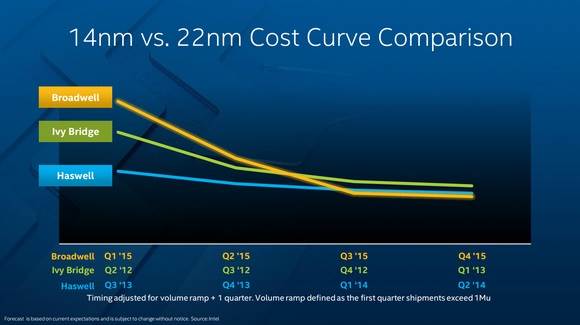Chip giant Intel is slowing down the clock on its development of processors. The company announced that it is ditching the so-called “tick-tock” approach to making chips that it has used for years.
Apparently, the move is in response to the growing difficulty in making smaller transistors and circuits that can hold the same amount of processing power as their larger predecessors. Instead, the company will slow down the rate at which it shrinks the components on its processors.
The tick-tock manufacturing model refers to that fact that about every two years, Intel would upgrade its fabrication facilities to manufacture chips using smaller transistors and circuits. That move, in turn, would increase transistor density as well as the performance and energy efficiency of the processors. That was the tick; the tock was when, in intervening years, Intel would release chips with a new microarchitecture.
The idea was a cycle in which Intel released a chip based on a new microarchitecture one year, followed by a new chip based on the same microarchitecture but made with smaller, denser transistors.
Not an Iron-Clad Law
“We’re seeing Moore’s Law slowing down,” Linley Gwennap, principal analyst with The Linley Group, told us. Moore’s Law is the observation that the number of transistors in a dense integrated circuit will double about every two years.
“You used to be able to count on that two-year cadence, but now manufacturers are admitting that a three-year cycle might be the new standard for the industry,” said Gwennap.
Intel will move to a cycle that focuses on process, architecture and optimization. It’s already using this approach with new processors based on the 14nm manufacturing process (14nm refers to transistors that are 14 nanometers apart on the surface of the chip). The goal has been to reduce that distance as chip transistors are reduced in size.
Slowing Cycle
The company was planning to release two 14nm chips this year, Broadwell and Skylake, followed by a 10nm chip, the Cannonlake model. But late last year, Intel said that Cannonlake’s release would be delayed until 2017, and instead it would release another 14nm chip, Kaby Lake. That chip is scheduled for release late this year. Intel said it will take a similar approach with the release of new chips, especially when it establishes the 10nm line.
Kaby Lake is based on the same microarchitecture as Skylake, not on a new microarchitecture. But it does promise enhanced performance and new features not on Skylake, Intel said.
One possible reason for the slowdown is simple physics: Chips made at 10nm and below are more prone to current leakage due to the limitations of traditional photolithographic methods. Alternative manufacturing processes are being explored by several chipmakers including Intel, but none are in production. “I’m thinking the cycle will be at least three years for 7nm models,” said Gwennap.
In an SEC filing released late last month, Intel reassured customers that since the struggle to shrink chips is affecting all manufacturers, the situation shouldn’t affect its standing as the top manufacturer in that field.







